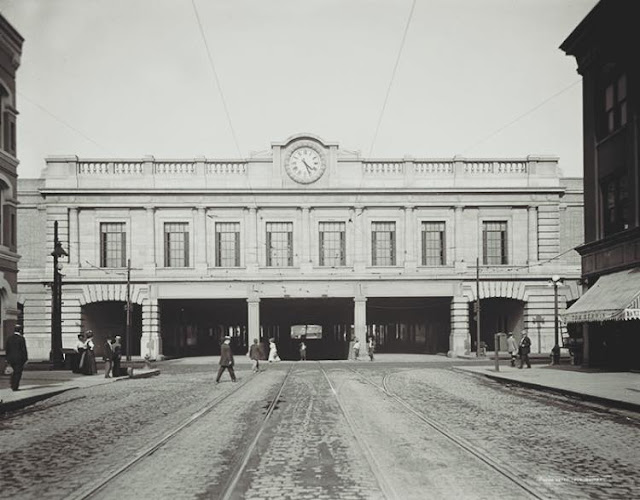Google Maps calls this Washington Street Bridge, but all of the bridge expert sites call it Washington Boulevard Bridge. I put "Street" in the title in parenthesis to make it easier to do a title search for this bridge.
The original crossing of the river here was done with the first vehicular tunnel that was built in 1868. (The only other tunnel was for La Salle Street, opened in 1870.) In 1891, the city moved the swing bridge that was at Madison Street to this location. The current bridge was built in 1913.
 |
| 20161021 6592, cropped [It is framed on the right by the Civic Opera House.] |
 |
| Street View of the northern elevation, Aug 2022 |
A history and photo collection written as part of a celebration of its 100th anniversary on May 26, 2013. This bridge is considered the first one of the second generation of Chicago-type bascule bridges because an effort was made to make the bridgehouses more attractive in accordance with the 1909 Plan of Chicago. Motivated by the need to build above the tunnel, a new foundation design technique was introduced tath was also used in subsequent bridges. And the 1911 patent by Chicago Public Works engineer Alexander von Babo was introduced. That design places the rack and pinion underground. (See Cortland Street Bridge for an example of the first generation rack-and-pinion design, which was above ground.) "During 1914, the first full year of operation of this bridge, a total of 9,540 vessels entered and cleared the Chicago River. The Washington Blvd. bridge opened 3,773 times in that year alone."
Historic Bridges uses the transition from a through truss to a pony truss as the distinguishing feature between the first and second generation Chicago-type bridges.
 |
| HAER ILL, 16-CHIG, 134-1 1. VIEW AT NIGHT OF WASHINGTON STREET BRIDGE WITH RAISED SPAN - Chicago River Bascule Bridge, Washington Street, Spanning Chicago River at Washington Street, Chicago, Cook County, IL |
Significance: The development of the Chicago trunnion bascule bridge occurred during the first three decades of the twentieth century. Despite the controversy over patent infringement — Joseph E. Strauss charged the City of Chicago engineers with infringing on his patented StraussTrunion bascule bridge — the Chicago bascule received great acclaim within the civil engineering profession. [HAER-data]
 |
| Tony Gutierrez posted The viaduct under the newly built station, for the new Chicago & Northwestern depot station. This is roughly around 1911. Chris Johnston: The center section (with the trolley tracks) was the entrance to one of the tunnels under the river. Scott Greig: It was there and open (fenced off) into the 80s. |
No comments:
Post a Comment